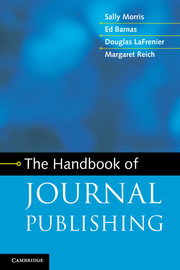Book contents
- Frontmatter
- Contents
- Preface and acknowledgments
- 1 Introduction to journals
- 2 Managing journals
- 3 Editing
- 4 The production process
- 5 Journal metrics
- 6 Marketing and sales
- 7 Fulfillment
- 8 Journal finances
- 9 Subsidiary income
- 10 Contract publishing
- 11 Copyright and other legal aspects
- 12 Ethical issues
- 13 The future of scholarly communication
- Appendix 1 Glossary
- Appendix 2 Resources
- Appendix 3 Vendors
- Index
Appendix 1 - Glossary
Published online by Cambridge University Press: 05 March 2013
- Frontmatter
- Contents
- Preface and acknowledgments
- 1 Introduction to journals
- 2 Managing journals
- 3 Editing
- 4 The production process
- 5 Journal metrics
- 6 Marketing and sales
- 7 Fulfillment
- 8 Journal finances
- 9 Subsidiary income
- 10 Contract publishing
- 11 Copyright and other legal aspects
- 12 Ethical issues
- 13 The future of scholarly communication
- Appendix 1 Glossary
- Appendix 2 Resources
- Appendix 3 Vendors
- Index
Summary
abstract A short summary (usually by the author, often within a set word limit) of the content of an article, usually published at the head of the article and generally freely available even when the article itself is not. Also third-party summaries included in some abstracting and indexing services (q.v.). A structured abstract is an abstract with distinct, labeled sections, often mimicking the IMRAD heading sequence (q.v.).
abstracting and indexing (A&I) service A database and/or publication of bibliographic information, with or without summaries, about the scholarly literature in a given field (e.g., Mathematical Reviews) or a related set of fields (e.g., Inspec); a few cover extremely large sets of journals (e.g., Scopus, Web of Science). A&I services now find themselves competing with general search engines such as Google and Bing.
acceptance rate The percentage of submitted papers that are accepted for publication. A high-profile, high-impact journal may have an acceptance rate of less than 10 due to a high volume of submissions far in excess of the available page budget. Many specialty journals have an acceptance rate of between 40 and 60 .
acid-free paper (sometimes known as permanent paper) Paper made for archival purposes. The specifications for manufacture are laid out in American Standard ANSI Z39 1984 and cover neutral pH, alkaline reserve, chemical finish, tear resistance, and fold endurance.
- Type
- Chapter
- Information
- The Handbook of Journal Publishing , pp. 403 - 427Publisher: Cambridge University PressPrint publication year: 2013

